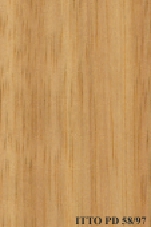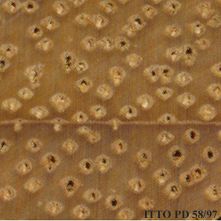
NAGA (Brachystegia eurycoma)
Trade Name
Naga
Scientific Name
Brachystegia eurycoma Harms
Family
LEGUMINOSAE
Common Names
Bodgei (Sierra Leone); Okwen (Nigeria); Tebako (Liberia); Meblo (Côte d`Ivoire); Okwen (United Kingdom); Mendou (Gabon); Ekop-naga (Cameroon)
Description Of The Tree
Botanical Description
The tree reaches a height of 40 m, with a trunk diameter up to 200 cm. The bole is short, up to 15 m in length and often curved, with large buttresses or rounded ridges at the base.
Natural Habitat
Brachystegia eurycoma occurs in dense rain forests.
Natural Distribution
Cameroon and Nigeria.
Wood Identification
Anatomic Description Of Wood
Wood diffuse porous. Occasionally vessels exclusively solitary (over 90%). Tangential diameter of vessel lumina 200 micras or more (large). Vessels per mm2 less than 6 (rare). Simple perforation plates. Vessel-ray pits similar to intervessel pits in size and s Axial parenchyma in marginal or in seemingly marginal bands. Axial parenchyma lozenge-aliform. Prismatic crystals in chambered axial parenchyma cells and/or in fibers. 3 to 4 cells per parenchyma strand. Rays more than 10 per mm (abundant). Rays and/or axial elements irregularly storied. Rays exclusively uniseriate. Homogeneous rays and/or sub-homogeneous rays (all ray cells procumbent). Non-septate fibers. Fibers with simple to minutely bordered pits.
-
 Wood Macro Photo Tangential Plane
Wood Macro Photo Tangential Plane
-
 Wood Micro Photo Of Transversal Section
Wood Micro Photo Of Transversal Section
Availability
Cites Status
Unrestricted
General Wood Description
Color
The sapwood is white to yellowish white, it has a thickness of 15 cm. The heartwood is pale brown to copper brown, it is clearly demarcated. The silver figure is fine (barely visible).
COLOR INDEX (1=Black, 7=Light yellow,white)
5
Grain
It has highly interlocked grain; special care is needed when drying because of frequent risks of distortion.
Texture
Medium texture is reported in this species.
Luster
The wood surface is low in luster.
Natural Durability
Moderately durable to decay. Without preservative treatment, this species can be used only under risk of occasional re-humidification. It is not suited for uses with risks of permanent or long-lasting humidification. Moderately resistant to termites attack
Natural durability index (1= Very high durability, 7=Vey low durability)
3
Resistance To Impregnation
Difficult to treat with only a low penetration of the preservative products.
Wood Physical Properties
Basic Density or Specific Gravity (O.D. weight/vol. green) (g/cm³)
0.56
Air-dry Density (Weight and volume at 12%MC) (g/cm³)
0.61
Total shrinkage Tangential (Saturated to 0%MC) (%)
7.3
Total shrinkage Radial (Saturated to 0%MC) (%)
4.8
Drying Defects
Ease of Drying: The rate of shrinkage are slow to moderate. From green to 12% moisture content 2.2-2.5% radial, and 3.8-4.0% tangential. Drying Defects: The timber seasons satisfactorily with little or no degrade, although precautions must be taken to prevent blue stains. Kiln Schedules: The recommended temperatures for kiln drying 25 mm thick boards from green to 15% moisture content are dry bulb 80-90oC and wet bulb 55-65oC.
Recommended Dry Kiln Schedule
FR-6
Dimensional stability ratio (Total Tangential Shrinkage %/Total Radial Shrinkage %)
1.5
Wood Chemical Properties
Wood Mechanical Properties
Bending Strength (MOR),12%MC (kgf/cm²)
1325
Stiffness (MOE) 12%MC (kgf/cm²)
105976
Compression parallel to fiber 12%MC (kgf/cm²)
560
Workability
Sawing
It is easy to saw.
Rotary Veneer Cutting
Suitable for slicing, also suitable for peeling if treated.
Sliced Veneer
Suitable for slicing, also suitable for peeling if treated.
Blunting Effect
Slight blunting effect; ordinary tools can be used for sawing and machining.
Machining
Machining of this species is reportedly easy.
Planing
Easy; no particular problems.
Moulding
Moderately easy; tools must be cautiously sharpened.
Boring
Moderately easy; tools must be cautiously sharpened.
Mortising
Moderately easy; tools must be cautiously sharpened.
Nailing
No particular problem.
Gluing
Glues well if basic gluing technical rules are followed.
Sanding
Easy to perform; it gives good results.
Polishing
Can be polished without surface preparation.
Steam Bending
This species can be used for steam bending.
Response To Hand Tools
No particular problems.
REFERENCED USES
End Uses Summary
HOUSING GENERAL, panelling, FURNITURE AND CABINETS, PLYWOOD AND VENEER, decorative
General Housing
- 10 - Silica in Timbers
Paneling
- 18 - W3TROPICOS Missouri Botanical Garden
Furniture Cabinets
- 21 - Tropical timbers of the world. Part III-Southeast Asian and Oceanian Species.
Panels, Veneers
- 25 - Directory of Timber Trade Malaysia
Decorative veneer
- 28 - Ministry of Agriculture, Fisheries & Forest of Fiji
Please Provide Information To View Producer Information